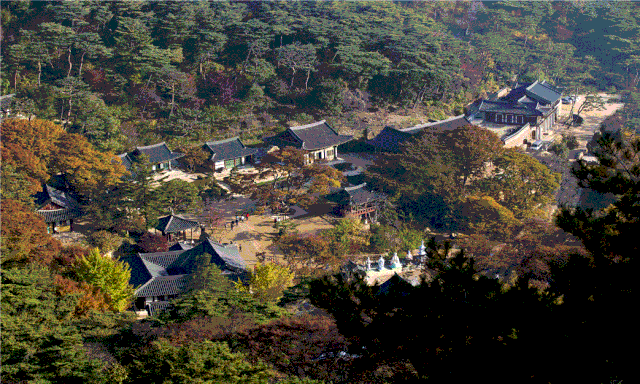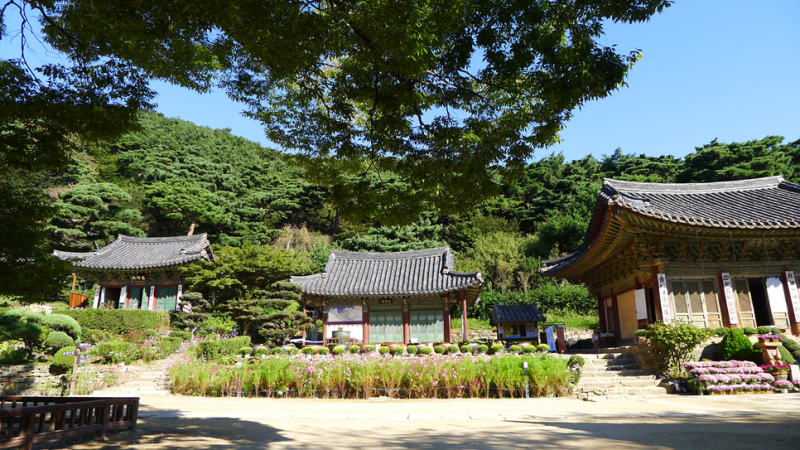
As the gentle breath of spring gradually awakens the landscape, the trees begin to stir with life, and nature unfurls its vibrant hues once more. For many, this season ignites a desire for exploration, prompting a meticulous examination of calendars to pinpoint the peak bloom of spring blossoms and the ideal destinations to witness this spectacle. The mere thought of fields awash in the delicate whites of plum blossoms, the sunny yellows of cornelian cherries, and the ethereal pinks of cherry blossoms stirs a sense of anticipation. This year, my journey leads to the historic and naturally resplendent Ganghwa Island, home to the venerable Jeondeungsa Temple, a sanctuary that has stood for a millennium.
Jeondeungsa: A Millennium of Tranquility
Nestled in Onsu-ri, Gilsang-myeon, Ganghwa-gun, Incheon Metropolitan City, Jeondeungsa Temple (傳燈寺) is revered as one of Korea's oldest Buddhist temples, with its founding traditionally traced back to 381 AD. Considering that Buddhism was introduced to Korea in 372 AD, Jeondeungsa's origins lie in the very nascent stages of Buddhism's presence on the peninsula, imbuing it with profound historical significance.
Initially named Jinjongsa (眞宗寺), the temple's appellation was later changed to Jeondeungsa during the Goryeo Dynasty. Legend recounts that Queen Jeonghwa, the consort of King Chungnyeol, donated a jade lantern to the temple, thus bestowing upon it the name meaning "Temple of the Transmitted Lamp." From the Silla Dynasty through the Goryeo and Joseon periods, Jeondeungsa has steadfastly endured the ebbs and flows of Korean history, a silent witness to centuries of change.
Encountering the Ancient Sanctuary
Despite its secluded location within the embrace of the mountains, Jeondeungsa thoughtfully provides access for visitors with disabilities, allowing 장애인 vehicles to reach the temple courtyard, ensuring a relatively seamless visit even for those using manual wheelchairs. The temple grounds can be entered through two main gates, the east and south gates of the Samnang Fortress (三郎城), which uniquely serve as the temple's informal Iljumun (一柱門), the typical first gate found at Korean Buddhist temples.
I chose the south gate as my entry point. Stepping through its threshold felt akin to traversing time itself. The serene atmosphere enveloped me as I moved forward, soon encountering the Budojeon (浮屠殿), a hall that eloquently narrates Jeondeungsa's long history. Rows of stupas, the burial monuments of revered past high monks, stood in solemn formation, exuding a palpable sense of reverence. Standing before these monuments, inhaling the woody fragrance carried on the breeze, I felt a connection to the countless individuals who had walked this sacred ground before me.
Further along the path, the Jeokmukdang (寂默堂), once a meditation hall for monks but now serving as living quarters and an administrative office, emanated a profound stillness, still resonant with its past purpose as a space for deep contemplation. I paused before it, reflecting on the centuries of history that permeated its very structure.
Greeting me near the entrance was a majestic ginkgo tree, over 600 years old. Its thick, rugged bark bore the indelible marks of time's passage. Resting beneath its expansive canopy, the rustling of its leaves in the gentle breeze offered a soothing balm to my spirit. Gazing upwards, I observed the tender new shoots emerging from its branches, a vibrant testament to the approaching spring. Warm sunlight filtered through the foliage, enveloping me in its embrace, and in that moment, a profound sense of peace and gratitude washed over me.
Treasures and Cultural Heritage
Jeondeungsa is a veritable repository of cultural treasures. A notable example is the Jeondeungsa Temple Bell (Treasure No. 393), originally housed in the bell pavilion beside Daejoru Pavilion but now located next to the Jeokmukdang. Additionally, the temple safeguards other historically significant artifacts, including the Yaksa Hall (藥師殿) and the Wooden Seated Triad of Sakyamuni Buddha (목조 석가여래 삼불좌상).
Tucked away on one side of the temple grounds is the Jeondeungsa mineral spring (약수터), where visitors, undeterred by the lingering chill of winter, partook in its refreshing waters, seemingly imbibing the very essence of nature. I too cupped my hands and drank a mouthful of the clear, cool water. Its subtle sweetness and invigorating coolness felt like a precious gift from the depths of the mountain.

Gazing at Grandeur from a Wheelchair
The main Buddha hall of Jeondeungsa, the Daeungbojeon (大雄寶殿, Treasure No. 178), though not expansive in size, showcases the exquisite architectural aesthetics of the mid-Joseon period. Its intricate carved decorations are captivating, making it a significant site for students of architecture. Access to the hall is solely via stairs, preventing a closer approach in my wheelchair, yet its grandeur was palpable even from a distance.
Opposite the Daeungbojeon stands the Daejoru Pavilion (大祖樓), offering a panoramic vista of the Ganghwa Strait. Seated in my wheelchair, the landscape unfolded before me with an enhanced sense of breadth and depth. The view of the distant sea from this elevated vantage point stretched the horizon, while the mingled scents of verdant foliage and the salty sea air awakened my senses.
The Daejoru is more than just a pavilion; it is an architectural marvel with a meticulously crafted design. Notably, the line of sight from Daejoru towards the Daeungbojeon is angled upwards at 25 degrees, aligning perfectly with my perspective from a wheelchair. This ingenious design naturally encourages one to lift their gaze, fostering a more reverent contemplation of the Buddha statue enshrined within.
Adjacent to the Daejoru, benches are thoughtfully placed, inviting visitors to linger and immerse themselves in the scenery. From this vantage point, with mountains and fields stretching as far as the eye can see, I absorbed the burgeoning energy of spring carried on the breeze. In this transitional moment, as the cold of winter recedes and the warmth of spring pervades, the view from my wheelchair offered a profound and unique sense of wonder.
Navigating for Accessibility
Upon departing from the initial parking area, the ascent to Jeondeungsa presents a long and steep incline. Consequently, there is a risk of wheelchair overload or slippage on loose gravel during the descent, necessitating the assistance of another person for safe navigation. My personal experience involved the wheelchair stopping on two or three occasions during the ascent, and a near-slipping incident on the way down, which was quite alarming.
Safety remains paramount during any journey. When planning accessible travel, thorough consideration of the gradient and safety of routes is essential. For those with concerns, it is advisable to arrange for drop-off directly at the Daeungbojeon courtyard to avoid the steep initial climb.
Spring's Embrace at Jeondeungsa
Jeondeungsa is not merely a temple; it is a sanctuary where a millennium of history converges with the beauty of nature, creating a truly special place. Its elevated location offers breathtaking views of the distant mountains and sea, making it an ideal setting to welcome the arrival of spring in a tranquil frame of mind.
Walking along paths still touched by the lingering coolness of winter, while basking in the increasingly warm sunlight, Jeondeungsa evokes a sense of traversing the very threshold of seasons. Inhaling deeply and slowly absorbing the scenery allows for a renewed appreciation of the journey itself.
As spring further graces Jeondeungsa with its beauty, I encourage you to consider experiencing the temple's thousand-year-old spirit alongside a warm cup of tea.
Accessibility Amenities
Accessible Restroom: While previously unavailable, a new accessible restroom has been recently constructed. However, the narrow doorway and limited interior space may pose challenges for practical use. For greater convenience, it is recommended to use the public restrooms near the parking area.
Restaurant: A wheelchair-accessible restaurant is located at the south gate entrance.
Jeondeungsa Information
Address: 37 Jeondeungsa-ro, Gilsang-myeon, Ganghwa-gun, Incheon Metropolitan City
Inquiries: ☎ +82-32-937-0125
Getting to Jeondeungsa via Public Transportation (Accessible)
From Seoul, take the Incheon Subway to Gyeyang Station. From there, utilize the Incheon Accessible Call Taxi service for convenient transportation to Jeondeungsa.
I boarded the accessible taxi at Gyeyang Station. While it is possible to travel to other areas within Ganghwa-do using this service, please note that for subway connections, reservations must be made before 4:20 PM, and boarding must occur before 5:00 PM.
Please keep this crucial timing in mind.
Further research reveals that Jeondeungsa is not only historically significant but also plays an active role in preserving traditional Korean Buddhist culture through various programs and events. The temple often hosts meditation retreats, traditional tea ceremonies, and cultural performances, offering visitors a deeper immersion into Korean spirituality and heritage.
The Samnang Fortress, within whose walls Jeondeungsa resides, also holds historical importance, dating back to the Goguryeo Kingdom. The fortress offers scenic walking trails with historical markers, providing an opportunity to explore the surrounding landscape and learn more about the region's past. While some sections of the fortress walls may not be fully accessible, the areas around the temple offer accessible pathways.
Furthermore, Ganghwa Island itself is rich in history and natural beauty, boasting dolmens (prehistoric megalithic monuments), historical museums, and picturesque coastal areas. Visitors to Jeondeungsa might consider extending their trip to explore these other attractions, making it a comprehensive cultural and natural excursion. The island is also known for its local produce and seafood, offering culinary delights to enhance the travel experience.
The efforts made by Jeondeungsa to improve accessibility, such as the new restroom facility and the accessible routes within the main temple area, reflect a growing awareness and commitment to inclusivity in Korean tourism. While challenges remain, the temple's dedication to welcoming all visitors is commendable and contributes to a more enriching experience for everyone.
In conclusion, a spring visit to Jeondeungsa Temple offers a unique blend of historical exploration, natural beauty, and spiritual reflection. The temple's enduring legacy, coupled with the burgeoning life of spring, creates an unforgettable experience, inviting all to partake in its timeless tranquility.
[Copyright (c) Global Economic Times. All Rights Reserved.]




























